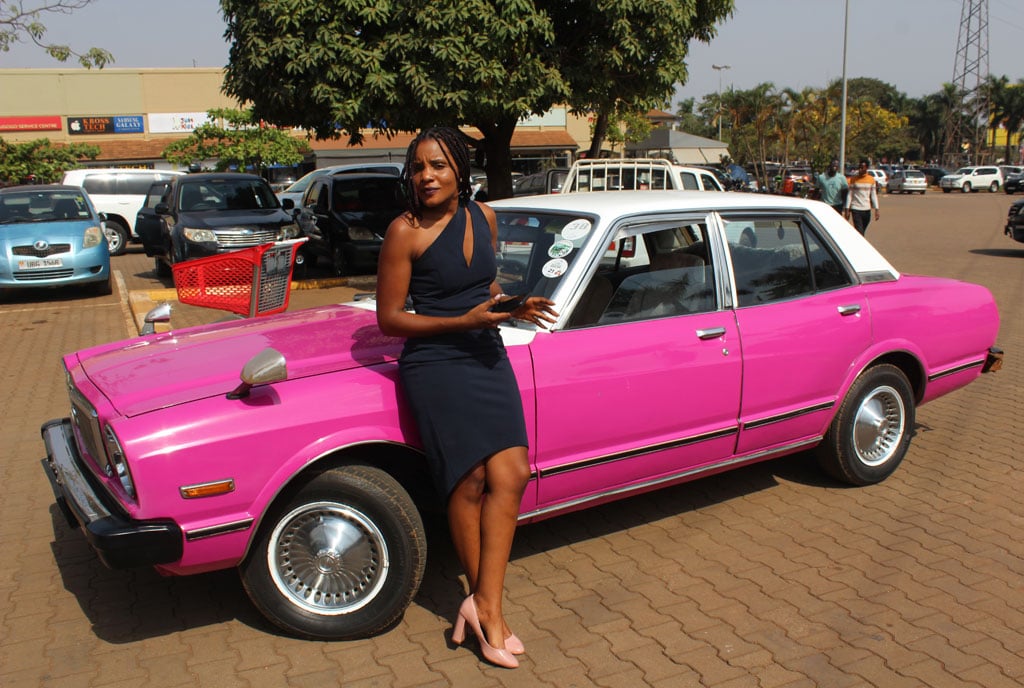Prime
How Ruth Kembabazi has kept her Corona for 13 years

Ruth Kembabazi on her car.
What you need to know:
- Initially, the 45-year-old saloon was imported into the country and registered under the Iranian Embassy and was owned by the embassy undersecretary for years. It was then sold to a one Emmanuel from whom Kembabazi bought it in 2010.
Ruth Kembabazi’s favourite colour is pink. No wonder, her 1978 Toyota Corona has a pink body and a white roof.
Initially, the 45-year-old saloon was imported into the country and registered under the Iranian Embassy and was owned by the embassy undersecretary for years. It was then sold to a one Emmanuel from whom Kembabazi bought it in 2010.
Specs
Even after more than 13 years of ownership, Kembabazi’s Corona still looks as good as new. Unlike modern cars whose dashboards are sometimes leather-coated or have elements of wooden trims that add beauty to the dashboard, the one for the 1978 Corona is purely metallic, only covered with a vinyl layer. This is also part of the car body. You cannot replace the dashboard as a single unit. It has to be cut or ground out from the car body. The steering and gear lever were perhaps made from the strongest wood.
Running on a 1990cc petrol, straight six-cylinder, automatic transmission engine, the 1978 Corona was among the first models that used Electronic Fuel Injection (EFI) technology. As opposed to the older versions, at the time of its production in 1978, Toyota had advanced its technology and the Corona no longer used carburetors.
Maintenance
Having been a diplomat’s car, at the time she bought it, the Corona was still in roadworthy condition. Apart from external body rust she had to restore, the engine and gear system were still functional.
“Spare parts are sometimes challenging to source. Fortunately, it shares some of them with some Toyota brands such as the Toyota Carina and the Toyota Levin. The biggest challenge are the outer body parts that take time to source,” Kembabazi says.
Some of the parts that experience frequent wear and tear include the brake master cylinder and mortars that raise and lower the windows. Also, the door handles tend to break especially if not handled with care.
“A number of passengers are not used to opening the old design door handles and tend to use a lot of force when opening them. Sometimes, they break and sourcing them becomes a costly venture,” says Kembabazi.
Spare parts
Fortunately, other parts such as the lights fit and blend well with those from other Toyota models of the same make. For example, the shock absorbers are similar to those used by the Toyota Mark II while the springs are similar to those of the ordinary Toyota saloons such as the Corolla.
“Getting spare parts for this car depends on what you are looking for. The external body parts such as tail or rear lights, windscreen and side mirrors are difficult to source locally yet they are the most vulnerable to wear and tear because of reckless motorists and motorcyclists,” she adds.
Kembabazi was, however, lucky that a vintage car enthusiast in Makindye had a similar car with all parts, while they had kept others in storage. The enthusiast, Kembabazi was told, intended to restore their Corona but gave up and that this has since become her primary source of spares.
At full capacity, the Corona’s fuel tank carries 60 litres. The furthest she has driven is Nairobi City in Kenya, and Kabale in western Uganda. To Nairobi, the Corona did not experience any mechanical breakdowns. However, on one of the trips, Kembabazi had to replace the fuel pump.
Cost
On average, if Kembabazi is to maintain her Corona in the best mechanical condition throughout the year, she spends approximately Shs600,000 on body work, which is her biggest cost.
Kembabazi does not replace or service the interior upholstery every year or replace any major parts. If she has not touched anything to do with body works, she only polishes and does ceramic coating. The coating keeps the gloss and the car shiny because it is affected by change in weather conditions and random washing at bays that degrade the quality of the paint. Ceramic coating gives an extra coat and all that is required is polishing at least once a month.
About
Introduced in Japan in September 1978, the T130 series Corona adopted a boxier design over the outgoing T100/110/120 series. It maintained the standard front-engine/rear-wheel-drive layout of all Coronas that preceded it.
The T130 series was available in a wide range of body styles across various markets including a four-door sedan, two-door hardtop coupe, four-door wagon and new five-door liftback, which featured a 40:60 split fold rear seat. The assignment of “T130” to all Corona body styles signified a new approach from having different series number identifiers for the various body styles. This was also the first Corona to be sold as a “Toyota” rather than a “Toyopet” in the Japanese domestic market.




